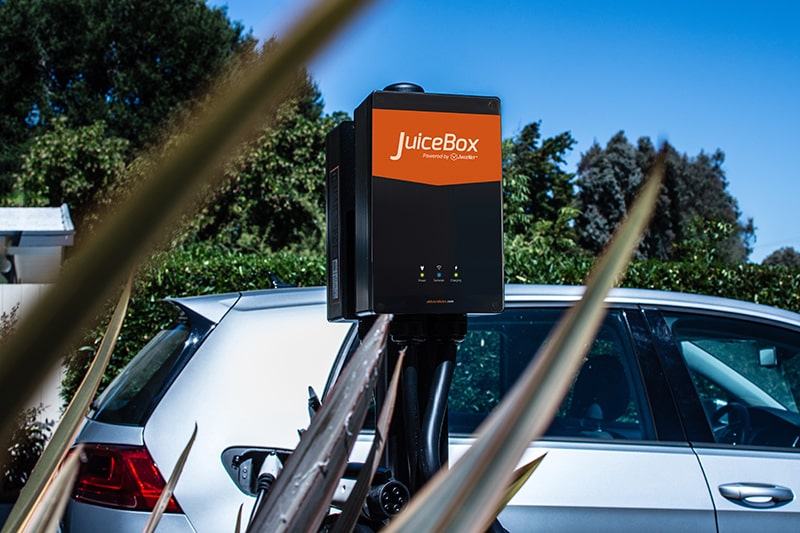Everything You Need to Know About Outdoor EV Charging

Charging your electric vehicle is a major component of any kind of EV ownership. Whether you are a homeowner, or even if you rent an apartment, using a home charging station to charge your car inside of a garage isn’t always an option. Outdoor charging is a perfectly suitable method for charging your electric vehicle, but there are some things you should know before you begin. This article will help you make an informed decision about charging outside and will serve as a guide for any questions you may have about outdoor EV charging.
Levels of Home Charging Stations
Before getting started, it’s important to explain how at-home charging stations work. At its most basic level, home charging stations are separated into different levels. Level one chargers are those which can be plugged directly into your home’s standard wall socket. Most electric vehicles can use the same 120-volt electricity that runs through your home. As stated earlier, there are charging options that allow you to plug your car into a standard grounded outlet like the one you would find in your garage.
One of the reasons we advise against level 1 charging is that it is not nearly as effective as a designated level 2 charging unit. This is not to say that a level 1 charging station won’t get the job done, it certainly will. Level 1 charging is a slow process and the time to charge your electric vehicle will be much longer. Because the power source being used limits current draw to 120 volts, the car cannot consume power the way it has the capacity to. As a result, most electric vehicle owners will only use level 1 charging as a last resort, or as a way to charge their car overnight. In a pinch, level 1 charging will be enough power to charge your car, but be prepared for a full charge to take somewhere between 10 to 12 hours.
The level 1 method adds complexity to your charging routine. Instead of just plugging in your car and then using power throughout the rest of the house, you must be conscious of how much power you are using with level 1 chargers. Due to the current draw of the car, the outlet being used must be on its own isolated circuit where no other electricity is being used.
Before using a tier-one system, always check the circuit breaker in your home to ensure that whatever power source you are connected to is on its own isolated circuit. Sometimes after the purchase of an electric vehicle, modifications need to be made to your home’s electrical grid, especially if you plan on using a level 1 system as your primary option for charging. It is important to remember that electricity is complicated and dangerous, and if you ever have questions, always consult a professional. Or, you could skip all the circuit breaker gymnastics that come as the result of a tier-one system and upgrade to a level 2.
There is no dancing around it, a level 2 charging system will make your life easier. Aside from being a no-hassle, problem-free solution to charging your electric vehicle, a level 2 charging system is better for your EV’s battery life. Level 2 home charging stations use a 240-volt connection to power your electric vehicle, quickly and efficiently.
Unlike a level 1 charging unit, level 2 charging systems use a different kind of plug and therefore cannot be plugged directly into a standard outlet. Two hundred forty volts is the key difference between level 1 and level 2. Most electric vehicles were made to engage with 240 volts. A piece called the capacitor limits electrical powered components, like the rechargeable battery in your electric car. Think of capacitors like a gate to ride a roller coaster at an amusement park.
Based on the limits set by a capacitor, the voltage must be within a specific range. For electric components that receive and hold a charge, there is a sweet spot for a current draw that is typically the median number set by the capacitor. This sweet spot is where your electric vehicle is able to absorb and retain power at an accelerated rate. In the case of your electric vehicle, the median voltage is 240, which is what makes a level 2 charging system the perfect match for your electric vehicle.
Which Level Charging Station is Best For Outdoor Use?
Now that you understand the differences between a level 1 and level 2 EV charging system, let’s discuss which EV charger is better for outdoor charging.
When it comes to the type of charger you should employ for outdoor use, we recommend nothing less than a level 2 EV charger. Due to all of the uncertainties that accompany outdoor electric vehicle charging, i.e., weather, pets, and environmental factors, level 1 charging just won’t cut it.
The upfront costs associated with cutting the level 1 cord and purchasing a level 2 system can be financially intimidating. However, upgrading to a level 2 charger will allow you to save a considerable amount of time in the long run of owning your vehicle and is the safer option for at-home EV charging.
The Upside of Charging Outside
The primary upside of charging outside is that your charger could be more conveniently located to your electric car if you park outside at home. Fortunately, our JuiceBox smart home charging stations are designed for all weather conditions, and are water and fire resistant. Our stations are UL certified and tested, and can be used both indoors and outdoors.
Believe it or not, your electric vehicle was made for harsh weather conditions in mind. The port where you plug in the cord to your car’s battery is designed to flush water and drain when charging an electric vehicle. Similarly, the cord itself is made to repel water, and once your level two charging system is connected to your car’s battery port, a watertight seal is created, ensuring a safe and reliable charge, even in the harshest of conditions. In the event that your car is exposed to rain or snow, you will still be able to charge your car.
Recommended Charging Location
When deciding indoor vs. outdoor charging for your home, indoor charging is the industry recommendation. Indoor charging protects your charging system connector and your car from animals, people, and the elements.
If you have a charging system installed so that it sits on the outside of your house, you can purchase a special enclosure to protect your charging equipment. Regardless of the neighborhood you live in, taking the extra precaution to lock up your equipment and charger accessories, ensures you will have the charge when you need it.
For outdoor charging systems weather can accelerate the aging process, but many JuiceBox home customers report continued usage well past the three-year warranty . If you choose to have a new charging system installed on the exterior of your home, a weatherproof enclosure is not necessary, but can help maintain the resale value of your charging station if you plan to upgrade down the line.
One of the great things about a level 2 EV charger is that it can be installed inside or outside with customizable length for the cable to extend to wherever your car is parked. One of the most common options for outdoor charging is to install the charging system inside the garage and then buy a longer cable that reaches their car. When electing for this kind of set up, it is important to remember to leave your garage door open with enough room to slide underneath the door without being pinched or impeded. Regularly buying replacement cords due to damage from things like garage doors can be a bit frustrating, so better to take care and keep the cord out of harm’s way.
Not All Outdoor Electric Vehicle Charging Happens at Home
While most people try to do their charging overnight from their own personal charging station, sometimes you run out of battery while on the road. In these situations, you’ll have to use a public charging station to get you to where you need to be.
Before you can use a public charging station, determine what kind of charge your car will need. As you can imagine, there are different types of electric vehicles, which means there are also different charging stations that you can use. Often, outdoor charging stations will have several designated spaces for charging. If your car is low on charge, you may need to use a high-speed fast charger.
Before you use a high-speed EV charging station, please note that the use of high-speed chargers will only be effective until you reach an 80% charge. Once your car reaches 80%, the battery begins to limit power flow and intake. This means that if your car is at 80% charge or higher, you should be using a level 2, 240-volt charger to finish the job.
Wrapping Up
Whether you are charging from the convenience of your own home or on-the-go in a public space, charging outdoors is a viable option for all EV owners. If you are looking to buy a charging station for home, keep in mind that Level 2 charging systems are a worthwhile investment and are the better option in the long run. Make sure to choose a brand like JuiceBox with a reputation of reliability and high-quality customer satisfaction before making your final purchase.



